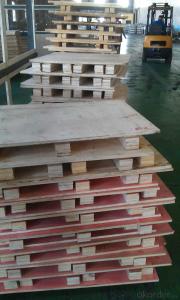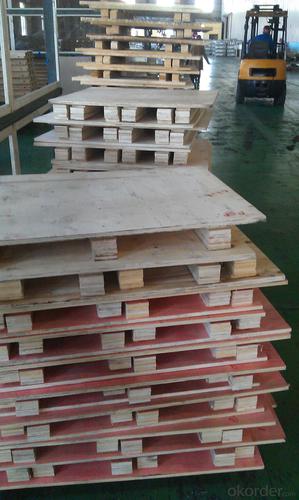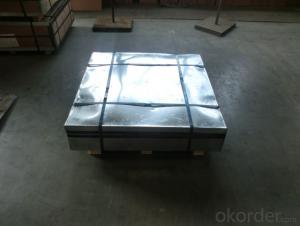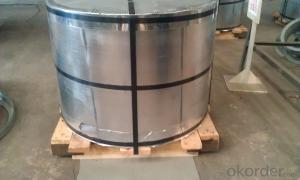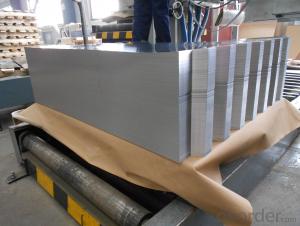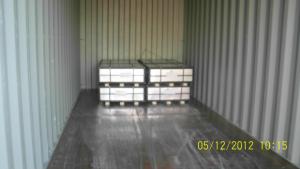Quality Tin Free Steel or TFS
- Loading Port:
- China Main Port
- Payment Terms:
- TT OR LC
- Min Order Qty:
- -
- Supply Capability:
- -
OKorder Service Pledge
OKorder Financial Service
You Might Also Like
Tin Free Steel (TFS)
Is also known as chromed steel, as it is obtained by coating the metal base (low-carbon steel) with an ultra-thin layer of metallic chrome and then with a chromium oxide layer.This steel product was developed to meet economic requirements, and excels tinplate in paintability, paint adhesion, and economy. It is widely used for making beverage cans and 18-liter cans. It is also used for making photographic film cases and as a protective material for optical fiber cables.
Our TFS Specification:
Standard: AISI, ASTM, BS, DIN, GB, JIS
Material: MR,SPCC
Thickness:0.15mm - 0.45mm
Width: 600mm -1150mm
Temper: T1-T5
Annealing: BA & CA
Coil Inner Diameter: 508mm
Weight: 6-10 tons/coil 1~1.7 tons/sheets bundle
Oil: DOS
Surface: Finish,bright,stone,matte,silver
Packing:
1、For sheets: plastic or waterproof paper, metallic cover and angles, steel strips,wooden pallet.
2、For Coils: plastic or waterproof paper,plastic protect plate,steel strips.
Both Prime and Second Quality Are Available!!!
- Q: Can tinplate be reused?
- Yes, tinplate can be reused. It is a highly recyclable material that can be melted down and reprocessed to create new tinplate products.
- Q: What are the main challenges in tinplate transportation?
- The main challenges in tinplate transportation include ensuring the proper handling and protection of tinplate materials to prevent damage or deformation during transit, managing the weight and size of the products to optimize shipping costs, and addressing any potential corrosion risks that may arise due to exposure to moisture or other environmental factors. Additionally, coordinating logistics and finding efficient transportation methods to ensure timely delivery and minimize any disruptions in the supply chain are also key challenges in tinplate transportation.
- Q: How does tinplate perform in terms of light protection?
- Tinplate performs fairly well in terms of light protection. Its metal composition provides a good barrier against light, preventing the penetration of UV rays and reducing the risk of light-induced degradation or spoilage of the contents. However, its light protection capabilities may vary depending on the thickness and quality of the tin coating applied to the steel substrate.
- Q: What are the typical lead times for tinplate production?
- The typical lead times for tinplate production can vary depending on factors such as the quantity required, complexity of the design, and the manufacturer's production capacity. However, on average, lead times for tinplate production usually range from several weeks to a few months.
- Q: How is tinplate affected by different types of beverages?
- Tinplate is generally resistant to most types of beverages, including acidic ones. However, certain highly acidic or corrosive beverages, such as fruit juices, can cause a chemical reaction with the tin coating, potentially leading to a metallic taste or discoloration. To prevent this, tinplate cans are often lined with a protective coating, such as lacquer or polymer, to ensure the beverage's quality and safety.
- Q: What are the limitations of printing on tinplate?
- There are several limitations to consider when printing on tinplate. First, tinplate is not a very smooth surface, which can affect the quality and resolution of the printed design. Secondly, tinplate is prone to corrosion, so special coatings or treatments may be required to ensure the longevity of the print. Additionally, tinplate is a rigid material, making it more challenging to print on curved or irregularly shaped objects. Lastly, the printing process on tinplate can be more time-consuming and costly compared to other printing methods, as it often requires specialized equipment and inks.
- Q: How does tinplate packaging handle exposure to different chemicals?
- Tinplate packaging is highly resistant to exposure to different chemicals, making it a reliable choice for packaging various products. Its non-reactive nature ensures that it does not contaminate or react with the contents inside, maintaining the product's quality and safety. Additionally, tinplate packaging is often coated with a protective layer, such as lacquer or enamel, further enhancing its resistance to chemical exposure. Overall, tinplate packaging proves to be a durable and dependable option when it comes to handling different chemicals.
- Q: What are the causes of tinplate rusting and how to prevent them?
- Attachment of impurities. The impurity is mainly caused by the difference of the impurity with the iron sheet, or the impurity adsorbed the water on the iron sheet to form a galvanic cell.
- Q: How does tinplate compare to other packaging materials in terms of shelf appeal?
- Tinplate stands out among other packaging materials in terms of shelf appeal due to its unique metallic appearance, which adds a sense of premium quality and attractiveness to the product. Its high gloss finish and ability to be printed with vibrant colors and intricate designs make it visually appealing, catching the attention of consumers and stimulating their interest. Additionally, tinplate offers excellent durability and protection, ensuring that the product remains in pristine condition on the shelf, further enhancing its shelf appeal.
- Q: How does tinplate affect the overall branding of products?
- Tinplate plays a significant role in shaping the overall branding of products. Its unique properties, such as durability, versatility, and high-quality appearance, contribute to creating a positive perception of the brand. Tinplate packaging enhances the visual appeal, protects the product from external factors, and provides a premium feel, which can ultimately elevate the brand image and consumer preference.
Send your message to us
Quality Tin Free Steel or TFS
- Loading Port:
- China Main Port
- Payment Terms:
- TT OR LC
- Min Order Qty:
- -
- Supply Capability:
- -
OKorder Service Pledge
OKorder Financial Service
Similar products
Hot products
Hot Searches
Related keywords
